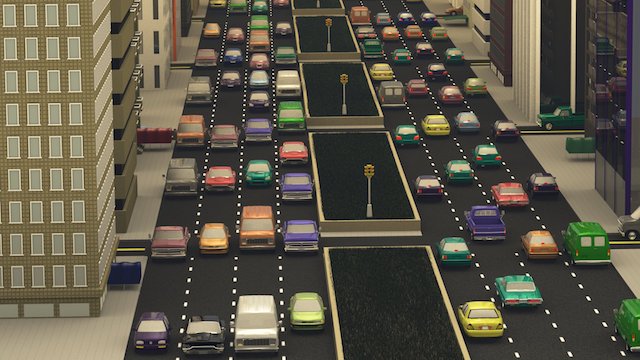Types of Traffic Models

Microscopic Models
Micro simulation is a computer modeling system which represents the behavior of individual vehicles and their drivers in a road network.
Microsimulation models track individual vehicle movements on a second or sub second basis. Microsimulation relies on random numbers to generate vehicles, select routing decisions, and determine behavior. Because of this variation, it is necessary to run the model several times with different random number seeds to obtain the desired accuracy. There will be a 'warm-up' period before the system reaches a steady state, and this period should be excluded from the results.
Microsimulation models usually produce two types of results: animated displays, and numerical output in text files. It is important to understand how the software has accumulated and summarized the numerical results to prevent incorrect interpretation. Animation can allow the analyst to quickly assess the performance, however it is limited to qualitative comparisons. The main indication of a problem that can be seen in an animation is the forming of persistent queues.
Traffic microsimulation describes the process of creating a virtual model of a city's transportation infrastructure in order to simulate the interactions of road traffic, and other forms of transportation, in microscopic detail. This involves treating each vehicle, bus, train, tram, cyclist, pedestrian etc. in the model as a unique entity with its own goals and behavioral characteristics; each possessing the ability to interact with other entities in the model.
Traffic microsimulation computer models capture the interactions of real world road traffic through a series of complex algorithms describing car following, lane changing, gap acceptance, and spatial collision detection. In addition, free form pedestrian movement is replicated using agent based spatially aware models allowing road traffic to interact with pedestrians as they do in the real world.
Macroscopic Models
A Macroscopic traffic flow model is a mathematical model that formulates the relationships among traffic flow characteristics like density, flow, mean speed of a traffic stream, etc. Such models are conventionally arrived at by integrating microscopic traffic flow models and converting the single-entity level characteristics to comparable system level characteristics.
Macro simulation models evaluate traffic flow as a whole without consideration of the characteristics and features of individual vehicles in the traffic stream.
Models of Traffic Flow
-
Poisson’s Models
-
Queuing Models
1. Poisson's Models:
Poisson's models of traffic flow are based on the assumption that vehicle arrivals follow a Poisson distribution. These models are often used to analyze traffic patterns and predict traffic volume at a specific location or during a particular time period. Poisson's models consider traffic flow as a random process, where the number of vehicles arriving at a given point follows a probabilistic distribution.
By understanding the characteristics of the Poisson distribution, such as the average arrival rate and the probability of specific traffic volumes, transportation planners and engineers can estimate the expected traffic demand, plan for adequate infrastructure, and optimize traffic management strategies.
2. Queuing Models:
Queuing models, also known as traffic flow queuing theory, focus on the analysis and prediction of traffic congestion and delays at intersections or roadway sections. These models treat traffic flow as a queuing system, similar to customers waiting in line at a service facility.
Queuing models consider factors such as arrival rates, service times (time taken for vehicles to traverse a specific section), and the number of lanes or service points available. By analyzing these factors, queuing models can provide insights into the behavior of traffic queues, the average delay experienced by vehicles, and the capacity of the roadway system to handle traffic flow.
Queuing models are useful for evaluating the effectiveness of traffic signal timings, determining optimal lane configurations, and identifying potential bottlenecks or areas of congestion. They help transportation planners and engineers make informed decisions to improve traffic flow and reduce delays.
These models are valuable tools for understanding and managing traffic flow. However, it's important to note that they are simplified representations of real-world traffic conditions and make certain assumptions. Real traffic flow is influenced by a wide range of factors, including driver behavior, road conditions, traffic control systems, and external events. Therefore, while these models provide valuable insights, they should be used in conjunction with real-time data and on-the-ground observations for accurate traffic management and planning.












